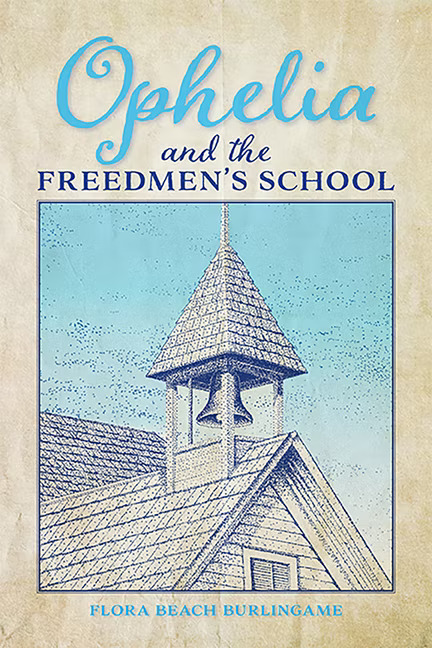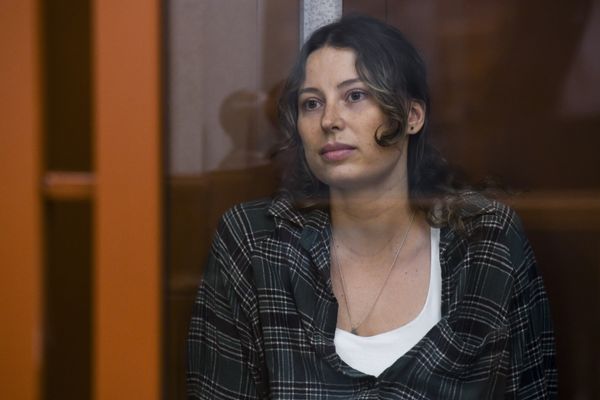Set in 1867, Flora Beach Burlingame’s Ophelia and the Freedmen’s School is historical fiction for children. The story follows twin sisters Ophelia and Melinda as they begin their education in the tiny Texas town of Lavaca, now known as Port Lavaca. The illiterate ten-year-olds attend a freedmen’s school, one of many created across the South during the Civil War and Reconstruction to provide a free education for former slaves and refugees. The only whites among forty students, the girls can learn without being shamed for their flour sack dresses, bare feet, or lack of schooling.
At first, Ophelia doesn’t like the classes, which are held in an old warehouse on the bay where the only teaching materials are boards and pieces of charcoal. She says, “My innards felt a little pinched ’cause I couldn’t figure out why the teacher, a white man, would pick this colored girl first instead of Melinda or me.” Her feelings of entitlement realistically reflect white opinions at that time, as does her surprise that some “coloreds” like Patsy are smarter than she is.
Still, everyone’s enthusiasm for learning is contagious. Soon the students can read and solve simple math problems. When Patsy says she’s going to be a teacher someday, the idea captivates Ophelia too. They celebrate on a day “better’n Christmas,” when a box of slates and chalk arrive. The “scholars” greet each acquisition with joy, but white resistance fuels escalating fears.
The girls’ educations expand beyond the boundaries of the the classroom. Before long, Ophelia and her sister confront “malcontents” in town who are against the schools. In spite of that, the girls form new friendships with their classmates. When the teacher Mr. Ogilvie asks Ophelia to mail a letter requesting more supplies, she walks to town with Ezra, a Black boy who knows to drop her hand and not go inside the store with her. But a fisherman on the street scolds Ophelia, saying, “Don’t seem proper,” then throws rocks as the children retreat, injuring Ezra.

After little Ezra brags that whites don’t “skeer” him, Ophelia says, “It riled me some that he kinda lumped all us white folk together. Melinda and me weren’t enemies just ’cause we were white. Then that there thought jarred me a little.” She realizes she once thought of the “coloreds” as “different” and “separate,” but now she sees classmates Patsy, Ezra, and Jeremy as equals and friends. Ophelia gains a new perspective about the reality of slavery, too, when she hears adults in the night school talking about former masters. There’s an honesty to both the girl’s and the author’s perceptions.
With great risk to her family, Patsy’s mom welcomes the white girls to her home, but because of her fear of KKK retribution, the twins’ mom doesn’t reciprocate. Ophelia and Melinda worry the KKK will hang their friends or harm their teacher. The girls realize that members are “right here among us.” The pacing and suspense work well as inevitable violence follows.
A skilled writer, Burlingame uses figurative language that fits the story’s setting. Her protagonist Ophelia says something “disappeared like a horny toad skittering under a rock.” She describes “scholars so excited they sounded like a bunch of grackles what couldn’t stop squawking.”
When I first read a description of Ophelia and the Freedmen’s School, however, I wondered why the protagonist was a white girl. The freedmen’s schools, after all, were created during Reconstruction to educate former slaves, so why write the story from her point of view?
On the other hand, TCU Press, the book’s publisher, has a catalog full of well-researched historical fiction. That motivated me to take a closer look. Once I read the author’s notes, I discovered the backstory. John Ogilvie (Stephenson), the white educator at the freedmen’s school in Lavaca, Texas, was the great-grandfather of the author Flora Beach Burlingame.
This is Burlingame’s third book based on research about her ancestor. She began her writing career at age fifty after raising her three children. The author returned to college for journalism classes and participated in other creative writing programs. While living in California, Burlingame sold articles to magazines and wrote features and columns for several publications.
Ogilvie’s letters, certificates, and scrapbook provided the foundation for the narrative in Ophelia and the Freedmen’s School. Several photos and scanned documents also appear in the author’s notes. The Rosenberg Library in Galveston now houses his papers in its archives.
Many of the heavily researched details about harassment of those involved in educating the former slaves are historical fact. John Ogilvie, for example, built a little house and lived among his “colored” scholars so that his presence wouldn’t threaten any whites who might offer him room and board. His neighbors were his students and they nursed him back to health when he contracted yellow fever during a Gulf Coast epidemic.
Ophelia plays a heroic role in the story, but with help from a Black adult. If the author had created dual points of view in alternating chapters, common in contemporary children’s books, the story might have taken different turns. She and Jeremy or Patsy or Ezra would all have different perspectives on the same events. What did those characters think about white girls going to their school? Should a white author write as a Black character or would the book need to be co-written? Flora Beach Burlingame’s well-researched and well-written book is great fodder for these discussions.
When I was a school librarian, I would have purchased this book and shared it with my students. Now, there’s incredible pressure on public schools to turn a blind eye to history. Like the author’s great-grandfather, educators face an uphill battle with state politicians and fearful parents interfering at every turn. Reading, sharing, and discussing this book is one way to fight that trend.
Someday I hope to read a TCU Press publication by a Black author who has a family history with the freedmen’s schools or the Rosenwald Schools in Texas. It would make a perfect companion for Ophelia and the Freedmen’s School.
Featured image caption: A freedmen’s school in South Carolina







